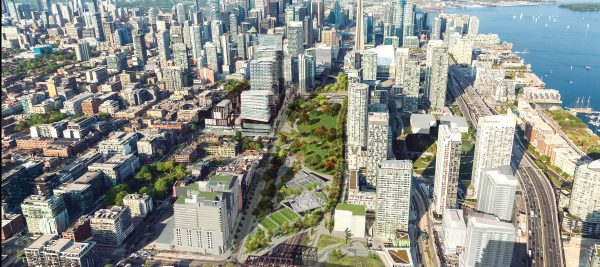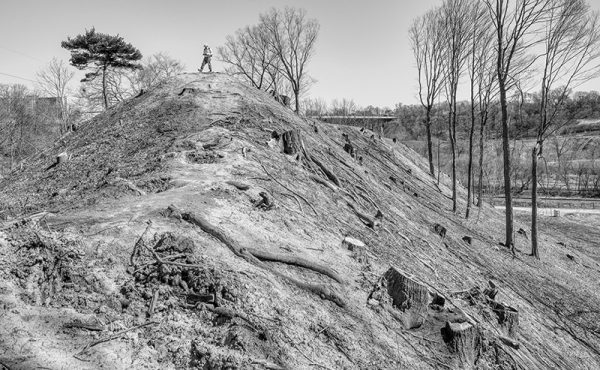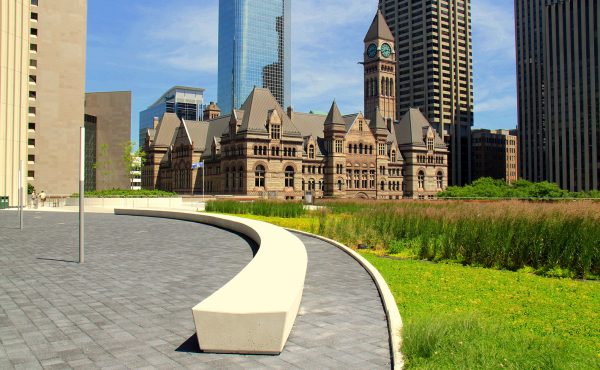George Popper is a Toronto architect
While Toronto desperately needs affordable housing, I believe the first step towards that goal is to create more housing generally. Why?
First, a significant factor in the high cost of housing in Toronto is the restricted supply. Some of the causes include over regulation, high development charges for missing middle housing, Official Plan Amendment 320, the elimination of the Ontario Municipal Board, and so on. By increasing supply, we will drive down the price of housing by introducing more competition into the market.
Second, an increase in the supply of housing, even high-end product, will free up housing units as buyers move up to higher and larger homes.
There could be three important areas where we can start to take dramatic action: Rail Deck Park; North York Downtown, and Bloor/Danforth
Rail Deck Park
This project would be a remarkable civic achievement for connecting the downtown to the waterfront with a huge public park. Tall buildings on the east and west ends, much like the structures that form the boundary of Central Park in New York, could help subsidize some of the cost of this undertaking. Perhaps no towers should be built at the north and south edges, as this would weaken the link to the waterfront.
Bringing Rail Deck Park to fruition will require a great deal of planning and thought. Perhaps an open design competition would help increase interest and enthusiasm. Calvert Vaux and Frederick Laws Olmsted’s design for Central Park in New York was the winning proposal in an open competition. As we build the much-needed housing, we also need the green open space for the mental and physical health of the population.
The period around 1910 was a time of great civic pride in towns and cities throughout North America. Many great libraries, courthouses, train stations and townhalls were constructed together with public squares, parks and infrastructure such as bridges, sewer systems, and streetcar systems. These were built with careful attention to design and at considerable cost. Toronto built the Prince Edward Viaduct in this period with the tremendous foresight to add a lower deck for a future subway, which only came into being two generations after the Viaduct had been built.
Rail Deck park will need a huge investment from all levels of government. We need a renewed sense of civic purpose to heal and strengthen our city.
North York Downtown
The stretch of Yonge between Sheppard and Finch has an interesting and relevant history in the debate over how to create more housing. In order to protect the “stable” neighbourhoods to the east and west of Yonge north of Highway 401, the former City of North York introduced a ring or barrier road to separate the high density developments along Yonge from the adjoining Willowdale neighbourhoods.
The blocks along Yonge had 20 to 30 storey buildings while those across the barrier street had one and two storey homes. Instead of creating a natural gradation of densities and heights, we have an abrupt change of use and form from one block to the next.
The Yonge subway line, a major public resource, is now sacrificed to the stability of the neighbourhoods nearby. In a perfect planning model, a major avenue with a subway should have tall buildings in the first block followed by mid-rise buildings in the second block. The third could have townhouses, stacked townhouses and four storey walk-ups. Only the fourth block away from the main avenue should have low density housing. The result would be a more natural and organic transition.
Instead, the barrier road functions like an urban wall in that there is no vehicular traffic allowed into the neighbourhood except at major intersections. Many urban thinkers, including Jane Jacobs, stressed connectivity. In North York, however, connectivity was thrown out the window to appease residents concerned about traffic flooding their streets.
These barrier streets are a scab on the urban fabric. North York then mayor Mel Lastman and his planners made a pact with the devil to get their downtown plan approved, all in the name of protecting the stability of these neighbourhoods.
The creation and execution of the perfect planning model would have caused some disruption, but it would have been for the benefit of all the future citizens. Some homeowners may have been dislocated, but their property values would have increased significantly which, arguably, would have more than offset the disruption.
The good news is that North York downtown can be fixed. We have skills and talent to do it. All it takes is political will and courage. Streets that don’t connect to the grid can be reconnected. Zoning to allow mid-rise buildings can be enacted. Neighbourhoods can change.
Bloor/Danforth
This arterial has predominantly two storey buildings for many kilometers. Although it is served by a subway, mid-rise buildings have scarcely been developed. This dearth represents an enormous missed opportunity.
To allow for significant intensification, the city would need a change to the Official Plan or a secondary Plan to allow the re-zoning of the blocks immediately to the north and south of the street. We must be able to take full advantage of the incredible infrastructure of the subway to build lots of housing. We would need to extend zones for higher density buildings beyond the properties fronting on Danforth and advance further into the neighbourhood.
The City must make this land use change to overcome a huge obstacle: the great expense of assembling narrow and costly lots in order to create a viable property for development. The zoning for this transitional zone must be attractive enough for builders and property owners to make the change freely and voluntarily. Development charge reductions may also be required to make these projects viable.
These three ideas would require bold action from City Council and from all levels of government. Let’s consider some examples of visionary leadership from the past.
Former Toronto planner Ron Soskolne imagined a public square at Dundas and Yonge where not had existed. His vision required that the City purchase or expropriate an entire block of commercial buildings. Some eggs had to be broken so that a fine omelette could be prepared.
We need the same kind of vision to achieve more housing and mixed-use buildings. But why do find it so much more difficult to expropriate residential properties than commercial ones? I understand the dilemma. Homes are, in a sense, sacred. They embody the hopes, dreams and memories of families. And yet we need to think of cities as treasured, too. That’s why we need to fix our city and create more housing. It is that simple.
Toronto’s Official Plan, which envisions mid-rise, mixed-use development along for the Avenues, was inspired by European cities such as Paris and London, as well as North American ones, like Washington D.C., where zoning rules prevent non-government buildings from rising higher than the U.S. congress. The result is a city with very walkable scale and enough density to support a fine subway system.
While no one expects Toronto to dramatic fashion itself after cities like Paris and London, it’s still the case that intensifying around downtown North York and the Danforth will require a significant change to some “stable” neighbourhoods, as well as political courage, bold thought and action.
I am not proposing the complete destruction of Toronto’s stable neighbourhoods. In fact, I believe strong neighbourhoods are an important asset of the city. Rather, I am calling for some fresh thinking in a handful of key locations where meaningful changes will result in significant addition of much needed housing. Toronto needs to think to the future and ensure that the city provides fair opportunities for work, transportation, recreation and housing for all its citizens.





4 comments
I agree pretty much completely. The problem, ironically enough, will probably be more with the “left,” than the “right” here, or at least equal.
1. Olmsted thought that Central Park would be a great place for people of all incomes and races to mix and possibly understand each other. Within a short time the Park was surrounded by expensive buildings and the park became pretty one dimensional. Rail Deck could become a tourist zone rather than part of an actual community and one must also wonder what other projects will be starved to create it.
2. The Yonge Subway was not “sacrificed”, there are a lot of tall buildings along that strip and most of that development was because of the subway (and the 401 too) in the first place. The service roads a block in were actually designed to let locals get around without having to enter or cross Yonge street which has become almost a highway. They look terrible but they work. Most of the folks who owned houses around there began to pass away in the late 80’s and then there was an influx of overseas buyers but you can see new developments starting on the other side of the service road at Byng Avenue and working its way in from the corners like on Kenneth. It looks like a natural progression that will continue. I grew up there and while I am not a big fan of Yonge (it should be narrowed or have a green space down the middle, I think overall its been a success and the density will grow in an organic fashion.
Image credit: PUBLIC WORK
I moved into a Seniors Building owned by the Toronto Housing. Before moving in I asked if there were any BED BUGS in the building, and was assured by the super that there were not any in the building. I was then given a few pages of typed and copied instructions on how to prepare my clothes and bedding before moving in. Wash my clothes and bedding dry them twice before taking them up to my apt. and putting them away. What a joke I think I was the only person that got these instructions other people just took the drawers out of their dressers and put them back in the dresser once they moved in. I moved in on a Friday and by Monday I was eaten alive by BED BUGS. When I complained to the super she answered I must have brought them with me. Why can the housing hire people that work and sub contractors that don’t play the granny game when they get paid for working (never finish the jobs the contracted for) Any money given to the TCHC would be better flushed down the toilet. I couldn’t work for the eight years before moving in here, never thought I was giving TCHC free labour instead of a place to live. My health has gone down hill since moving in here.